|
|
|
|
|
 BUSSHI 仏師 OF JAPAN = SCULPTORS OF JAPAN BUSSHI 仏師 OF JAPAN = SCULPTORS OF JAPAN
Who Made Japan’s Buddha Statues?
Sculptors, Schools & Workshops
in Japanese Buddhist Statuary
SPECIAL UNKEI PAGE, 24 PHOTOS
March 2008 Update: Unkei Statue Sells for $12.8 M
Unkei & Kamakura Statuary
Before starting, please see the Busshi Index. It provides an overview of Japan’s main sculptors (Busshi) and sculpting styles, a helpful A-to-Z Busshi Index, plus definitions for essential terms and concepts. This section of our site includes 14 pages, covers 100+ sculptors, features 100+ photos, and provides the web’s first-ever integrated guidebook to Japan’s sculptors. |
|
Unkei 運慶 (death 1223)

|
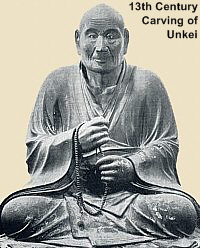
Unkei, Painted Wood
H 77.6 cm, 13th Century
Roku Haramitsuji Temple
六波羅蜜寺 in Kyoto
Photo courtesy Heibonsha
|
|
 It is impossible to exaggerate the importance of Unkei to the world of Japanese Buddhist statuary. He is the undisputed champion of Kamakura-era statuary, which featured a new realism, heroic spirit, power and passion, muscular bodies, plump fleshy faces, and virile strength. He was the leader of a sculpting school based in Nara called the Keiha School (慶派), which dominated Japanese Buddhist statuary in the 13th and 14th centuries. His life has been well documented. Although many of his works are still extant, most have been lost. He grew up during a very turbulent time in Japanese history (see Kamakura Period), and lived and worked in the three most important cities of his age -- Nara, Kyoto, and Kamakura. His efforts to remake and restore the great temple treasures of Nara and Kyoto, plus his early exposure to the raw emotions of the Kamakura region and the new military class (which scorned the aristocratic tastes and indulgences of the Kyoto imperial court and nobility) greatly influenced his artwork. He became the most influential artist of his time, achieving the highest rank of Ho-in (Hō-in, Hōin), and today is perhaps Japan’s most widely known Buddhist sculptor. It is impossible to exaggerate the importance of Unkei to the world of Japanese Buddhist statuary. He is the undisputed champion of Kamakura-era statuary, which featured a new realism, heroic spirit, power and passion, muscular bodies, plump fleshy faces, and virile strength. He was the leader of a sculpting school based in Nara called the Keiha School (慶派), which dominated Japanese Buddhist statuary in the 13th and 14th centuries. His life has been well documented. Although many of his works are still extant, most have been lost. He grew up during a very turbulent time in Japanese history (see Kamakura Period), and lived and worked in the three most important cities of his age -- Nara, Kyoto, and Kamakura. His efforts to remake and restore the great temple treasures of Nara and Kyoto, plus his early exposure to the raw emotions of the Kamakura region and the new military class (which scorned the aristocratic tastes and indulgences of the Kyoto imperial court and nobility) greatly influenced his artwork. He became the most influential artist of his time, achieving the highest rank of Ho-in (Hō-in, Hōin), and today is perhaps Japan’s most widely known Buddhist sculptor.
THREE SCHOOLS OF SCULPTURE
ALL SPRANG FROM JOCHO’S WORKSHOP
|
Note: The above chart is based in part on one appearing in Mori Hisashi’s book Sculpture of the Kamakura Period (ISBN 0-8348-1017-4). The KEIHA school rose to prominence under Kokei, Unkei, and Kaikei. As for Unkei’s father, KOKEI, little is known of his lineage. Most think he was an apprentice of either Kojo or Kocho.
|
|
Artists of Japan’s Kei School
See Keiha School Page for Reviews of Below Artists
Data from Sculpture of the Kamakura Period (ISBN 0-8348-1017-4)
Also from 日本史小百科 ・彫刻 ・久野健編 ・近藤出版社刊

 Unkei’s Early Years Unkei’s Early Years
The son of Kōkei (Kokei) 康慶, a noted Busshi with a workshop in Nara, Unkei soon demonstrated a talent for carving. His earliest known sculpture is one of Dainichi Buddha 大日如来 that he made in +1176 under the guidance of his father. The inscription for this piece says “chief busshi Unkei, true apprentice of Kōkei.” The phrase “true apprentice” tells us that Unkei was the actual son of Kōkei, not an adopted son.
Around +1186, Unkei was commissioned by the new military overlords in Shizuoka and Kanagawa Prefectures to carve Buddhist statuary for various temple projects. Both locations were far away from the aristocratic cultures of Nara and Kyoto. His journey to eastern Japan exposed Unkei to the new warrior class in these regions, and gave Unkei an understanding of their taste for bold, powerful, and passionate religious art and their distaste for the delicate and perfumed embroidery favored by the court and nobility in Kyoto.

|
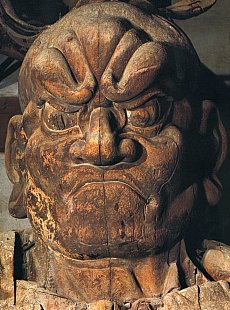
Ungyo (Ungyō) 吽形 H. 842.3 cm
Kongo (Kongō) Rikishi 金剛力士
Wood with Paint (Saishiki 彩色)
By Unkei & Kaikei, Dated +1203
Todaiji (Tōdaiji) Temple 東大寺
See more photos below.
|
|
 Unkei’s Middle Years Unkei’s Middle Years
Unkei was back in Nara around +1195 (perhaps earlier) and was engaged in work at Tōdaiji Temple 東大寺 with his elderly father Kōkei 康慶 and other Kei artists, including his younger brother Jōkaku (Jokaku) 定覚 and Kaikei 快慶, one of Kōkei’s most brilliant apprentices. These four men were, at the time, the core of the Nara Busshi.
Once work ended in +1196, Unkei traveled to Kyoto to carve and repair statuary for various temples, most notably Jingo-ji 神護寺 and Tōji 東寺. In +1198, he was named Daibusshi at Tōji Temple in Kyoto, and by +1202 he was awarded special assignments from the imperial court.
It should be noted that his main rivals, the Kyoto Busshi, had recently lost their veteran leaders -- Inson of the Inpa school died in +1198, followed by Myoen of the Enpa school in +1199. Unkei was at center stage, supported not only by the military government in Kamakura but also by the court in Kyoto.

 Unkei’s Final Years Unkei’s Final Years
Unkei moved his family to Kyoto around +1203, and also set up his own workshop in Kyoto’s Shichijo (Shichijō) 七条 area. The Keiha flourished. The original Shichijō Bussho workshop, set up five generations earlier by Kakujo, expanded to three locations -- Shichijō Naka Bussho 七条中仏所, Shichijō Higashi Bussho 七条東仏所, and Shichijō Nishi Bussho 七条西仏所, and artists from both the Inpa and Enpa schools began adopting and incorporating the robust and bold styles of the Kei school, which was directed by Unkei and his friendly Keiha rival Kaikei.
SUMMARY. Unkei is the true genius of the Kamakura-style of bold and powerful statuary, and the greatest sculpture of this genre of statuary. He spent his formative years in Nara, the birthplace of Japanese sculpture (see Photo Tour of 39 Nara Statues). As a young man, he traveled to Kamakura to work for the military class, where we can assume he developed his style of heroic and robust statuary, which featured heavily fleshed bodies, plump and expressive faces, virile masculine overtones, spiritual passion, and a new sense of realism along with the frequent use of inset crystal eyes. And he did so while still retaining the beauty and majesty of the classical statuary made in the centuries before him. Upon his return to Nara around +1195, he helped create and restore statues for two of its greatest temples. In his final years, he lived in Kyoto and established his workshop there, creating many statues for the court, temples, and the warrior class in Kamakura. This gave him the chance to closely study and repair/restore/recreate the statuary of Japan’s main temples in both Nara and Kyoto. In my mind, his statuary represents the pinnacle of Japanese Buddhist statue-making.

Extant Works by Unkei. The below treatment follows that of author Mori Hisashi in his book Sculpture of the Kamakura Period.
- Around +1176. Dainichi Buddha 大日如来. Unkei’s earliest known work. Lacquer & gold leaf over wood. Height = 101 cm. Dated +1176. Enjoji (Enjōji) Temple 円成寺 in Nara. Inscription on statue says work began in +1175 and was completed in +1176. See photo below.
- Around +1180, Unkei commissioned a transcription of the Hokekyo (Hokekyō) 法華経 or Lotus Sutra (Skt = Saddharmapundarika-sutra), which was simply labeled “great petition.” Scholars believe he commissioned this transcription to ensure the success of the Nara Busshi in reconstructing the statuary of the Kofukuji (Kōfukuji) Temple 興福寺 and Todaiji (Tōdaiji) Temple 東大寺, both in Nara and both burnt to the ground by Taira Shigehira 平重衡 in +1180 during the Genpai War 源平合戦 (Genpei Kassen, + 1180 to 1185). In the postscript appear the names of other contemporary Nara Busshi, including Kaikei, Ryokei, Genkei 源慶, Jokei, and Ninkei.
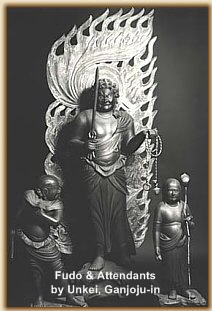  Around +1186. Statues of Amida Nyorai 阿弥陀如来 (see photos below), Bishamonten 毘沙門天, and Fudo Myo-o (Fudō Myō-ō) 不動明王 along with his two attendants Seitaka Doji (Dōji) 制た迦童子 and Kongara Doji (Dōji) 矜羯羅童子. All are dated to +1186, and all found at Ganjoju-in (Ganjōju-in) Temple 願成就院, Shizuoka Prefecture 静岡県. See photo at right and also photos below. The temple was built by Hojo Tokimasa, Yoritomo’s father-in-law, to pray for success in his (Hojo’s) military campaigns. In +1752, inscriptions were found inside the Bishamon statue and Fudo statue proving they were made by Unkei and sponsored by Hojo Tokimasa. <Source: Heibonsha Survey of Japanese Art, Volume 11> Around +1186. Statues of Amida Nyorai 阿弥陀如来 (see photos below), Bishamonten 毘沙門天, and Fudo Myo-o (Fudō Myō-ō) 不動明王 along with his two attendants Seitaka Doji (Dōji) 制た迦童子 and Kongara Doji (Dōji) 矜羯羅童子. All are dated to +1186, and all found at Ganjoju-in (Ganjōju-in) Temple 願成就院, Shizuoka Prefecture 静岡県. See photo at right and also photos below. The temple was built by Hojo Tokimasa, Yoritomo’s father-in-law, to pray for success in his (Hojo’s) military campaigns. In +1752, inscriptions were found inside the Bishamon statue and Fudo statue proving they were made by Unkei and sponsored by Hojo Tokimasa. <Source: Heibonsha Survey of Japanese Art, Volume 11>
- Around +1189. Statues of the Amida Nyorai 阿弥陀如来 and Two Attendants, Fudo Myo-o (Fudō Myō-ō) 不動明王, and Bishamonten 毘沙門天 at Jorakuji (Jōrakuji) Temple 常楽寺 in Kanagawa, dated +1189. See various photos below. Panels inscribed inside the statues claim they were made by Unkei in +1189. The panels also stated that Unkei had, by this time, made statues at Kofukuji Temple (Kōfukuji 興福寺) in Nara, thus attesting to his strong association with the Nara Busshi and the Nara workshop, under the direction of his father, Kokei (Kōkei) 康慶, from which he had sprung.
- Around +1195, Unkei’s father Kokei (Kōkei) 康慶 transferred his titles and workshop to his successor, Unkei. By at least +1196, there is evidence that Unkei was back in Nara, working with his father, his brother Jokaku (Jōkaku) 定覚, and Kaikei 快慶 on statuary at Todaiji (Tōdaiji) Temple 東大寺 in Nara. Regrettably, those statues are no longer extant. Once work ended in +1196, Unkei traveled to Kyoto to carve and repair statuary for various temples, most notably Jingo-ji 神護寺 and Toji (Tōji) 東寺. In +1198, he was named Daibusshi at Toji Temple in Kyoto, and by +1202 he was awarded special assignments from the imperial court. Extant statues from this period include two statues that Unkei repaired for Toji Temple between +1197 and 1198 -- one of Fudō Myō-ō and one of Kongoho (Kongōhō) Bosatsu 金剛宝 (Skt. = Vajraratna; south, jewel). Both were originally made around +839, both are considered famous, and both are still extant. There were other projects for Toji Temple and Jingo-ji Temple, often sponsored by the military government in Kamakura, but these statues have not survived. During this period of his life, Unkei was exposed to many of the great wooden statuary treasures of the Heian era, and this no doubt influenced his subsequent development as a genius of wood carving.
- Around +1198. Eight Great Child Attendants to Fudō Myō-ō (Hachidai Dōji 八大童子). Located at Kongobu-ji Fudo-do (Kongōbuji Fudōdō) Temple 金剛峯寺不動堂 on Mt. Koya (Kōya) 高野 in Wakayama Prefecture. The Fudō statue, built around +1198 and later moved to its current location, is thought to be the work of Monk Gyosho (Gyōshō) 行勝 +1130-1217. Six of the eight statues that accompany this Fudō image are attributed to Unkei, and also dated around +1198.
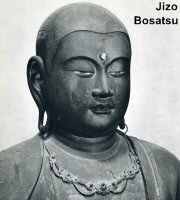  Around +1200. Unkei moved to Kyoto and established a workshop in the Shichijō area. He also set up a family temple named Jizō Jurin-in nearby. The temple is no longer extant, but the main image of the temple was saved, and according to many, it is now located at Roku Haramitsuji Temple 六波羅蜜寺 in Kyoto. It is an image of a seated Jizo (Jizō) Bosatsu 地蔵菩薩, attributed to Unkei despite any solid evidence. Painted Wood. H = 89.5 cm. Late 12th Century. Around +1200. Unkei moved to Kyoto and established a workshop in the Shichijō area. He also set up a family temple named Jizō Jurin-in nearby. The temple is no longer extant, but the main image of the temple was saved, and according to many, it is now located at Roku Haramitsuji Temple 六波羅蜜寺 in Kyoto. It is an image of a seated Jizo (Jizō) Bosatsu 地蔵菩薩, attributed to Unkei despite any solid evidence. Painted Wood. H = 89.5 cm. Late 12th Century.
- Around +1203. Unkei, Kaikei, and other Keiha sculptors work on remaking statuary for Todaiji (Tōdaiji) Temple 東大寺 in Nara. Two giant effigies (approx. 8.5 meters in height) of the Nio Guardians 仁王 stand guard outside the South Main Gate, both produced under the direction of Unkei and Kaikei, both considered masterpieces, both representing the zenith of the new Kamakura style. Photos of the Nio pair are shown below. He was probably awarded the highest rank possible, Ho-in, at this time, but records are unclear.
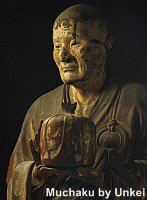  Around +1208. Statue of Indian Patriarch Muchaku (Mujaku). Painted wood. H 194 cm. Dated about +1208-1212. Located at Kofukuji (Kōfukuji) Temple 興福寺 in Nara. Masterpiece of realism and portraiture. See photo below. Also statue of another Indian patriarch, at same temple. Around this time, he also carved an outstanding image of Miroku Bosatsu 弥勒菩薩 for Kōfukuji. Around +1208. Statue of Indian Patriarch Muchaku (Mujaku). Painted wood. H 194 cm. Dated about +1208-1212. Located at Kofukuji (Kōfukuji) Temple 興福寺 in Nara. Masterpiece of realism and portraiture. See photo below. Also statue of another Indian patriarch, at same temple. Around this time, he also carved an outstanding image of Miroku Bosatsu 弥勒菩薩 for Kōfukuji.
- From +1213 to +1223. Unfortunately, statues from this point forward are no longer extant. He made statues for Hosshoji (Hōshōji) Temple 法勝寺 in Kyoto (no longer extant), working alongside his son Tankei and sculptors from the Inpa and Enpa schools. He also accepted numerous commissions from the military government in Kamakura during this period, but none of these works have survived. He passed away quietly in +1223. His line was carried on by his six sons, all pursuing careers as Buddhist sculptors.

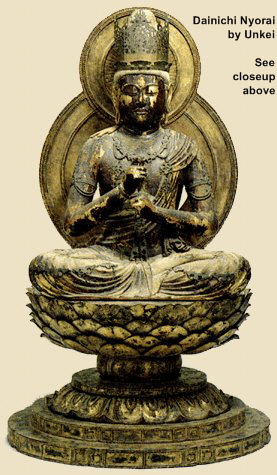
Dainichi Buddha 大日如来 by Unkei 運慶
Unkei’s earliest known work. Lacquer & gold leaf over wood.
Height = 101 cm. Dated +1176. Enjoji (Enjōji) Temple 円成寺 in Nara
Photo courtesy Handbook on Viewing Buddhist Statues.
By author Ishii Ayako. ISBN 4-262-15695-8. Japanese only.

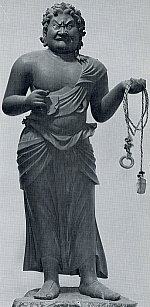 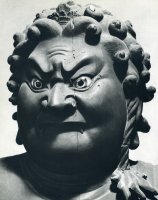
ABOVE: Fudo Myo-o (Fudō Myō-ō) 不動明王 by Unkei 運慶
Painted Wood, H = 136.5 cm. Dated +1186
Ganjoju-in (Ganjōju-in) Temple 願成就院, Shizuoka Pref. 静岡県
Photos courtesy Heibonsha Survey of Japanese Art
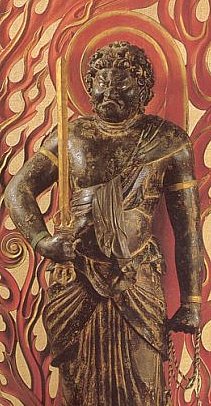
Fudo Myo-o (Fudō Myō-ō 不動明王) by Unkei 運慶
Painted Wood. H 134 cm. Dated +1189
Jorakuji (Jōrakuji) Temple 常楽寺, Kanagawa Pref. 神奈川
Photo courtesy Handbook on Viewing Buddhist Statues.
By author Ishii Ayako. ISBN 4-262-15695-8. Japanese only.

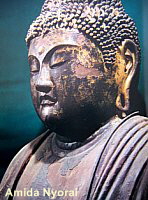 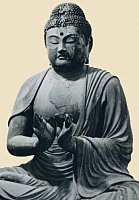
Amida Nyorai 阿弥陀如来 by Unkei 運慶
Two views of same statue.
Lacquer & gold leaf over wood. H = 143.5 cm. Dated +1186.
Ganjoju-in (Ganjōju-in) Temple 願成就院, Shizuoka 静岡県
Photos from web & from Heibonsha Survey of Japanese Art
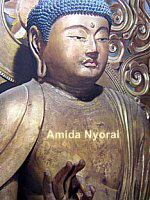 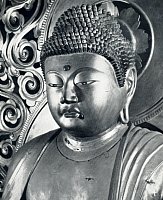
Amida Nyorai 阿弥陀如来 by Unkei 運慶
Two views of the same statue by Unkei.
H = 140 cm, Dated +1189
Jorakuji (Jōrakuji) Temple 常楽寺, Kanagawa Pref. 神奈川
Photos from web & from Heibonsha Survey of Japanese Art


One of the most famous Nio pairs 仁王 in Japan can be found at the entrance gate of Todaiji (Tōdaiji) Temple 東大寺 in Nara. The 26-foot-tall statues were made in +1203 AD under the direction of the famous sculptors Unkei and Kaikei.
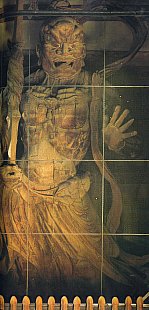 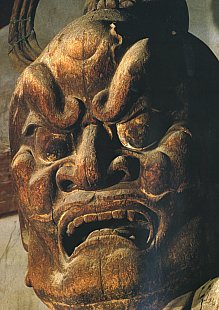
Agyo (Agyō) 阿形 H = 836.3 cm. Kongo (Kongō) Rikishi 金剛力士.
Wood with paint (saishiki 彩色). Made by the famous Keiha School of sculptors
(including Unkei and Kaikei) in the Kamakura Era. Todaiji (Tōdaiji) Temple 東大寺, Nara.
Photos courtesy temple catalog.
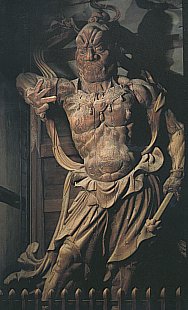 
Ungyo (Ungyō) 吽形 H = 842.3 cm. Kongo (Kongō) Rikishi 金剛力士.
Wood with paint (saishiki 彩色). Made by the famous Keiha School
of sculptors (including Unkei and Kaikei) in the Kamakura Era.
Todaiji (Tōdaiji) Temple 東大寺, Nara. Photos courtesy temple catalog.

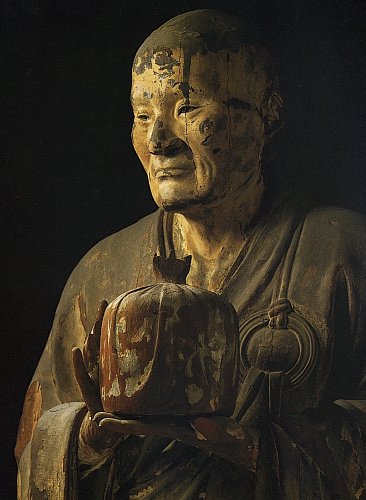
Masterpiece of Realism & Portraiture
Asanga (Jp. = Muchaku, Mujaku 無著). Carved by Unkei.
Indian Patriarch of Hosso (Hossō) 法相宗 Sect. H = 194.7 cm. Colored Wood. Dated around +1208.
Treasure of Kofukuji (Kōfukuji) Temple 興福寺, Nara. Photo courtesy temple catalog.

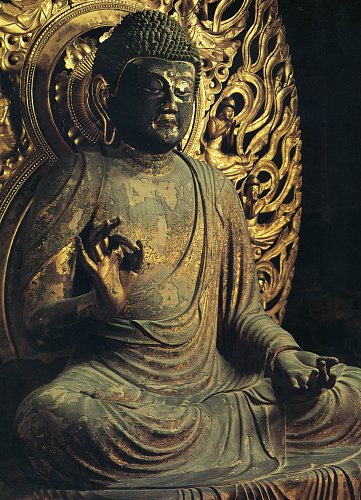
Miroku Bosatsu 弥勒菩薩 (By Unkei). Wood, Lacquer & Gold Leaf.
H = 143.5 cm, Dated +1208-12. Kofukuji (Kōfukuji) Temple 興福寺, Nara. Photo courtesy temple catalog.

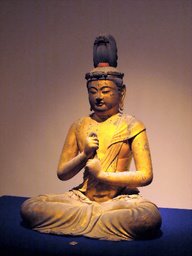  Unkei's wood sculpture sells Unkei's wood sculpture sells
for record $12.8 million in NY
NEW YORK, March 18, 2008 (AP)
A newly discovered wood sculpture attributed to the legendary sculptor Unkei sold Tuesday (March 18, 2008) for $12.8 million, or about 1.25 billion yen, in New York, the highest ever for any Japanese or Buddhist artwork auctioned in the world, said British auction house Christie. It was purchased by department store Mitsukoshi on behalf of a post-war Japanese Buddhist sect named Shinnyo-en <details on sect>. The sect manages a massive endowment of assets donated by followers.
A newly discovered wood sculpture attributed to the legendary sculptor Unkei sold Tuesday for $12.8 million, or about 1.25 billion yen, in New York, the highest ever for any Japanese or Buddhist artwork auctioned in the world, British auction house Christie's said.
Major Japanese department store operator Mitsukoshi Ltd. made a successful bid for the 12th century sculpture against a private American collector, according to the auction house. "History was made today with the phenomenal result of $14,377,000, which is a testament to the extreme importance and beauty of this supreme Buddha," said Katsura Yamaguchi, international director for Japanese and Korean Art. Yamaguchi was referring to the price with premium charged by the auction house.
Unkei was a favorite among warriors of the Kamakura period (1192-1333) known for his realistic and dynamic renditions of Buddhist figures.
The event has drawn strong interest from bidders as it was the first time that a work attributed to Unkei was put to auction outside Japan. Christie's said before the auction that the supreme Buddha "is the most valuable work ever offered in the category" of Japanese and Korean Art. The final bidding price shattered the presale estimate of $1.5 million to $2.5 million.
The Dainichi Nyorai figure, decorated in gold foil, is 66.1 centimeters tall and made of Japanese cypress. It sits on lotus position, with hair piled in a high topknot and wearing the crown and jewelry of royalty. According to Christie's, the statue has been owned by a private collector based in the northern Kanto region near Tokyo since 2000. The statue, originally housed in a temple in Ashikaga, Tochigi Prefecture, is believed to have been lost during the late 19th century when the Meiji government enforced a widespread anti-Buddhist movement in a bid to unite Japan under its native religion Shinto.
The Tokyo National Museum inspected the statue in 2003 with X-rays and found inside several dedicatory items, including a wood placard with pagoda-shaped finial and crystal ball supported by a bronze lotus stand that are characteristic to the school of Buddhist sculptors led by Unkei. Tsutomu Yamamoto, professor at Seisen University who conducted the examination, has said the statue dates back to the late 12th century and is likely attributed to Unkei based on its facial expressions, clothing design and the technique with which its hair is carved. But the statue has not been designated as a cultural asset by Japan's Cultural Affairs Agency, a status that would oblige the owner to inform the government of any plans for a sale. The agency so far designated 12 works made or believed to have been made by Unkei as national treasures or cultural assets.
"It was spectacular, because we're only here to bid on some small goods. And actually this was the first time for me to join the actual auction," said Frederick White, 56. "Buddha himself must have been surprised by this." © (Kyodo) News March 2008
For more details, see Gabi Greve’s Unkei page on this topic.
Also see Asahi Newspaper article (Japanese only).

Shinnyo-en 真如苑. Below text courtesy http://www.shinnyo-en.org
Shinjo Ito (1906-1989), the founder of Shinnyo-en, was ordained as a Shingon monk at Kyoto's Daigoji 醍醐寺 Monastery. After World War II, he established his own independent denomination and in 1952 he and his followers officially registered "Shinnyo-en" as a religious organization. When Shinjo died in 1989, leadership of the organization was passed along to his daughter Shinso Ito. Shinnyo-en literally means "Garden of Absolute Truth" or "Garden of the True Buddha" or "Field of the Tathagata." The organization provides mentoring and meditative training to lay practitioners and draws its inspiration from the Nirvana Sutra 涅槃經 and the important Buddhist philosophical concept of "thusness" -- written 眞如 or 真如 or Shinnyo. The concept refers to the eternal, impersonal, and unchangeable reality behind all phenomena. The organization does not (and need not) report its earnings, but most observers say it commands millions and millions in assets given freely by followers.

ENGLISH RESOURCES
- JAANUS. Japanese Architecture & Art Net Users System. Online database devoted to Japanese art history. Compiled by the late Dr. Mary Neighbour Parent, it covers both Buddhist and Shintō deities in great detail and contains over 8,000 entries.
- Dr. Gabi Greve. See her page on Japanese Busshi. Gabi-san did most of the research and writing for the Edo Period through the Modern era. She is a regular site contributor, and maintains numerous informative web sites on topics from Haiku to Daruma. Many thanks Gabi-san !!!!
- Heibonsha, Sculpture of the Kamakura Period. By Hisashi Mori, from the Heibonsha Survey of Japanese Art. Published jointly by Heibonsha (Tokyo) & John Weatherhill Inc. A book close to my heart, this publication devotes much time to the artists who created the sculptural treasures of the Kamakura era, including Unkei, Tankei, Kokei, Kaikei, and many more. Highly recommended. 1st Edition 1974. ISBN 0-8348-1017-4. Buy at Amazon
 . .
- Classic Buddhist Sculpture: The Tempyo Period. By author Jiro Sugiyama, translated by Samuel Crowell Morse. Published in 1982 by Kodansha International. 230 pages and 170 photos. English text devoted to Japan’s Asuka through Early Heian periods and the development of Buddhist sculpture during that time. ISBN-10: 0870115294. Buy at Amazon.

- The Great Age of Japanese Buddhist Sculpture, AD 600-1300. By Nishikawa Kyotaro and Emily J Sano, Kimbell Art Museum (Fort Worth) and Japan House Gallery, 1982. 50+ photos and a wonderfully written overview of each period. Includes handy section on techniques used to make the statues. The Great Age of Japanese Buddhist Sculpture (AD 300 - 1300)
 . .
- Comprehensive Dictionary of Japan's National Treasures. 国宝大事典 (西川 杏太郎). Published by Kodansha Ltd. 1985. 404 pages, hardcover, over 300 photos, mostly color, many full-page spreads. Japanese Language Only. ISBN 4-06-187822-0.
- Bosatsu on Clouds, Byōdō-in Temple. Catalog, May 2000. Published by Byōdō-in Temple. Produced by Askaen Inc. and Nissha Printing Co. Ltd. 56 pages, Japanese language (with small English essay). Over 50 photos, both color, B&W. Some photos at this site were scanned from this book. Of particular use when studying the life and work of Jōchō Busshi.
- Visions of the Pure Land: Treasures of Byōdō-in Temple. Catalog, 2000. Published by Asahi Shimbun. Artwork from Byōdō-in Temple. 228 pages, Japanese language with English index of works. Over 100 photos, color and B&W. Some photos at this site were scanned from this book. No longer in print. Of particular use when studying the life and work of Jōchō Busshi.
- Numerous Japanese-language temple and museum catalogs, magazines, books, and web sites. See Japanese Bibliography for extended list. Also relied on Hōryūji Temple 法隆寺 (Horyuji) catalogs and Asuka Historical Museum.

  JAPANESE RESOURCES JAPANESE RESOURCES

|
|